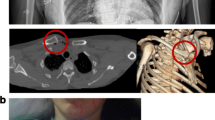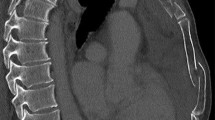Abstract
Introduction
We present a case series of three patients with manubriosternal dislocation and/or sternal fractures.
Method
We describe our experiences of invasive surgical treatment with 3.5/4.0 mm fixed-angle plate (Locking compression plate, LCP) in this group of patients. Recommended nonoperative treatment options, e.g. correction tape or plaster bandage, symptomatic pain treatment, application of ice, and several weeks without sports are associated with a not inconsiderable rate of subluxations or reluxations with an increased risk of pseudarthrosis and chronic pain syndrome.
Results
Due to a small number of cases and the lack of controlled studies, a standardized operative procedure could, therefore, so far not been established.
Conclusion
Our positive experiences with the operative treatment using 3.5/4.0 mm fixed-angle plate (LCP) may help to establish the operative procedure of first choice in this group of patients.








Similar content being viewed by others
References
Anderson LD, D’Alonzo RT (1974) Fractures of the odontoid process of the axis. J Bone Joint Surg Am 56(8):1663–1674
Cameron HU (1980) Traumatic disruption of the manubriosternal joint in the absence of rib fractures. J Trauma 20(10):892–894
Dastgeer GM, Mikolich DJ (1987) Fracture-dislocation of manubriosternal joint: an unusual complication of seizures. J Trauma 27(1):91–93
Fowler AW (1957) Flexion-compression injury of the sternum. J Bone Joint Surg Br 39-B(3):487–497
Henley MB, Peter RE, Benirschke SK, Ashbaugh D (1991) External fixation of the sternum for thoracic trauma. J Orthop Trauma 5(4):493–497
Hills MW, Delprado AM, Deane SA (1993) Sternal fractures: associated injuries and management. J Trauma 35(1):55–60
Kalicke T, Feil E, Steuer K, Hansis M (2001) Manubriosternal dislocation caused by indirect flexion-compression trauma. A case report and review of the literature. Unfallchirurg, 104(3):257–260
Kalicke T, Frangen TM, Muller EJ, Muhr G, Hopf F (2006) Traumatic manubriosternal dislocation. Arch Orthop Trauma Surg 126(6):411–416
Kurzweg FT, Danna SJ, Lolley RT Jr (1972) Open reduction and fixation of a comminuted fracture of the sternum. J Thorac Cardiovasc Surg 63(3):424–426
Lemaitre J, Koriche C, Massard G, Wihlm JM (2004) Manubriosternal disjunction a new approach for surgical repair. Acta Chir Belg 104(5):593–595
Scher AT (1983) Associated sternal and spinal fractures. Case reports. S Afr Med J 64(3):98–100
Thirupathi R, Husted C (1982) Traumatic disruption of the manubriosternal joint. A case report. Bull Hosp Jt Dis Orthop Inst 42(2):242–247
Watanabe S, Nakamura T, Shimizu Y, Hitomi S, Ikada Y (1989) Traumatic sternal segment dislocation in a child. Chest 96(3):684–686
Author information
Authors and Affiliations
Corresponding author
Rights and permissions
About this article
Cite this article
Gloyer, M.A., Frei, HC., Hotz, T.K. et al. Osteosynthesis of traumatic manubriosternal dislocations and sternal fractures with a 3.5/4.0 mm fixed-angle plate (LCP). Arch Orthop Trauma Surg 131, 1261–1266 (2011). https://doi.org/10.1007/s00402-011-1297-2
Received:
Published:
Issue Date:
DOI: https://doi.org/10.1007/s00402-011-1297-2




